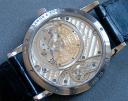Sun 19 Aug 2007
Micro-Rotors on Automatic Watches – How Cool?
Posted by The Breitling Source under General Posts1 Comment
So Cool! The first time I saw a micro rotor, I thought it was the coolest looking thing I had ever seen, and I still really would like to have a watch with a visible micro rotor. For those of you that may not know what a micro rotor (or a 3/4 rotor) is, its a rotor that does not cover the entire circumference of the movement. Most traditional rotors encircle the whole back of the movement like so:
But micro rotors allow the movement to be thinner, and also look pretty cool to boot! One recent micro rotor design are the ones used in some of the L.U.C. Movements by Chopard, particulary the ones in their 1.96/3.96 movements. These movements have an incredibly high power reserve as well.
There was an article in WatchTime several months ago debating the pros and cons of micro-rotors and why each company selected the ones they did for a given movement. The results are interesting, and I’ve summarized some of the points that the watchmaker’s made for and against the micro-rotors.
1. Micro-Rotors allow for an overall thinner movement.
2. Central-Rotors allow for an overall smaller diameter movement.
3. This third point allows for some debate among some watchmakers… physics tells us that a centrally mounted rotor would reated the greatest oscillating mass, ergo, more efficient winding. However, some watchmakers argue that in practice, this efficiency is negligable. Thierry Nataf from Zenith has even provided the mathematical calculations to prove that the microrotor has less static torque. Approximately a -76% loss of static torque when going from a full-sized central rotor to a half-sized micro-rotor.
4. Shock absorbancy is at it’s best when the rotor is mounted concentrically around the periphery of the movement and shock absorber.
5. It is argued that the Microrotor allows for easy addition of complications, however there are plenty of central rotor designs that complications are easily added to as well.
6. Chopard claims that the reason other manufacturers opt for centrally mounted rotors is because they have not been able to design mechanisms that can use a microrotor without compromising winding efficiency, any maybe he’s correct, albeit a bit arrogant!
7. Chopard is also able to position twin barrels one on top of the other without sacrificing thickness because of the use of the microrotor.
8. The Microrotor allows for an unimpeded view of the beautiful jeweling and finishing work that goes into a high-end movement, especially when you have an exhibition back. This is one of the best reasons for having a microrotor in my opinion!
So there you have it folks.. some of the reasoning behind the choices that some of the companies have made regarding central and micorotors. Ultimately its not a huge concern to me, but I would definately like to own a nice micro-rotor watch someday, maybe something like this A Lange and Sohne:








July 1st, 2010 at 5:40 am
[…] Breitling och Hamilton- Büren och var när det kom den första automatsika kronografverket med mikro-rotor. En typisk designegenskap är att datumet är placerat vid kl 6/18 och de två knapparna som […]